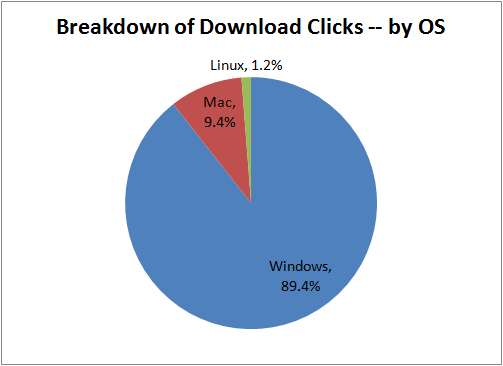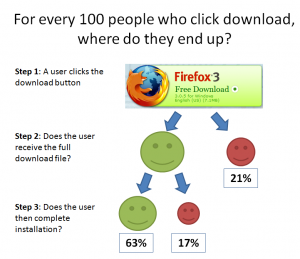We recently dug into the user’s experience when downloading Firefox, answering questions such as, “of people clicking the Firefox download button at mozilla.com, how many receive the full file and how many complete the installation process?”
With the latest Funnelcake shipment (January 13th), we wanted to take these insights a bit further, and breakdown that question above in several dimensions – by OS, by browser, and by geographical region. In this post, we’ll focus on the first dimension, i.e., how does the experience of users differ based on operating system?
To start, let’s look at the distribution of users who clicked the download button (on the mozilla.com homepage or main Firefox product page).
There’s nothing too surprising to note here. This distribution should come close to mirroring the overall population of Firefox users and the population of internet users more generally.
Next, let’s see exactly what happened at the moment of clicking the download button. You’ll recall from our previous post that we asked, “for every 100 people who initiate the download process, where exactly do they end up just a few moments later?”, and the answer was visualized through the diagram below:
(Note: while the percentages above highlight November’s Funnelcake edition, they remained almost identical in January).
Moving onto the punchline, below is the breakdown of these numbers by OS:
A couple key things to note:
- There seems to be a substantial difference between Mac and Windows users. While both groups are able to successfully receive the file at roughly similar rates, the experience of users diverges once they move from downloading to completing the installation.
- We’re not entirely sure what’s going on with the Linux numbers. Much more digging needs to be done.
Update: First, we should explain how we measure whether or not a user installs Firefox. We count an installation as successful when a user visits the Firefox firstrun page. Given this fact and considering Alix’s point below, it’s clear that Mac installations will be undercounted in this analysis, as Mac users have to manually launch Firefox for the first time in order to be counted as an install, while Windows users automatically hit the firstrun page.



Majken “Lucy” Connor wrote on
:
wrote on
:
Alix Franquet wrote on
:
wrote on
:
Donnie Berkholz wrote on
:
wrote on
:
Corey Burger wrote on
:
wrote on
:
Gervase Markham wrote on
:
wrote on
:
Mark wrote on
:
wrote on
:
Jesse Ruderman wrote on
:
wrote on
: